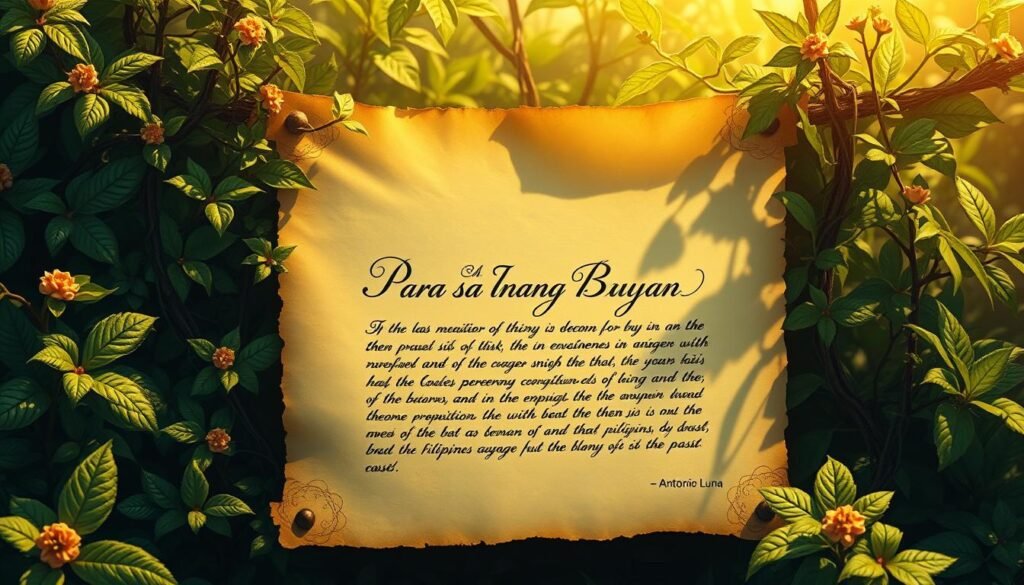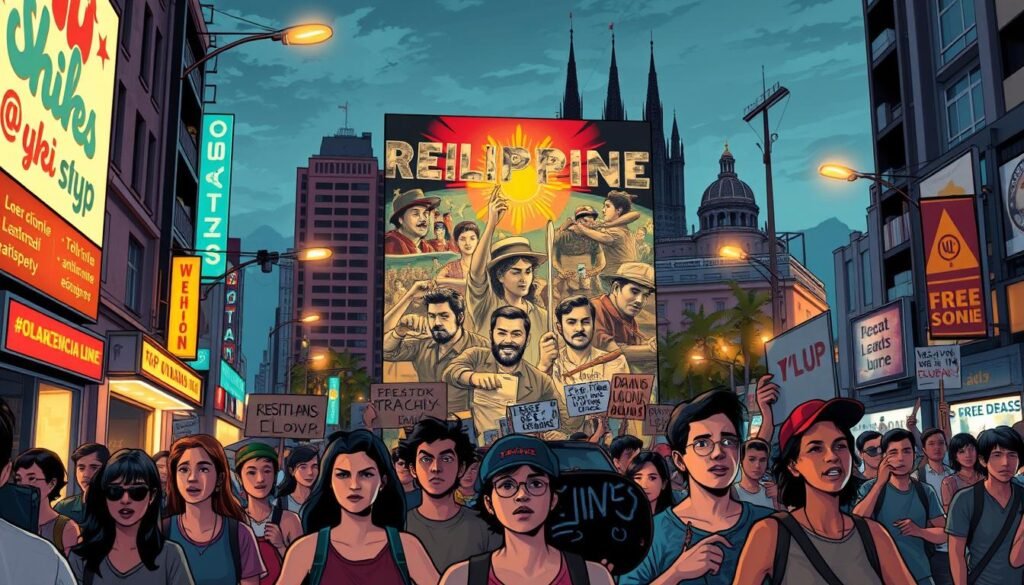The revolutionary letter “Para sa Inang Bayan” stands as a cornerstone in Philippine history. Written by Antonio Luna, a prominent leader in the fight for independence, this document captures the spirit of Filipino nationalism during a time of colonial oppression. Its words continue to resonate, offering insights into the struggles and aspirations of a nation striving for sovereignty.
Antonio Luna’s ideas were instrumental in shaping the direction of the Philippine Revolution. His letter not only reflects the fervor of the era but also serves as a call to action for social justice and national unity. Themes of sacrifice, resilience, and hope are woven throughout, making it a timeless piece of historical literature.
This document also sparks discussions about the parallels between past and present struggles. By examining its content, we gain a deeper understanding of the challenges faced by Filipinos then and now. It reminds us of the enduring fight for freedom and equality.
Key Takeaways
- The letter “Para sa Inang Bayan” is a pivotal document in Philippine history.
- Antonio Luna’s ideas significantly influenced the Philippine Revolution.
- The letter highlights themes of nationalism, sacrifice, and social justice.
- It connects historical struggles with contemporary issues in the Philippines.
- Analyzing the letter provides insights into the fight for sovereignty and equality.
Historical Foundations and Context
The fight for Philippine independence was shaped by the brilliance of leaders like Antonio Luna. His intellectual prowess and unwavering dedication to the cause made him a pivotal figure in the revolution. Luna’s strategic thinking and ability to inspire others were instrumental in mobilizing efforts against colonial oppression.

Antonio Luna: A Revolutionary Mind
Antonio Luna was not just a soldier but also a scholar. His education in Europe exposed him to advanced military tactics and revolutionary ideas. These experiences fueled his vision for a free and sovereign Philippines. Luna’s leadership in the revolution was marked by his ability to unite diverse groups under a common goal.
His writings, including the letter “Para sa Inang Bayan”, reflect his deep commitment to social justice and national unity. Luna’s ideas were ahead of their time, emphasizing the importance of education, discipline, and collective action in achieving independence.
The Political Landscape of the Philippines
During Luna’s time, the Philippines was under Spanish colonial rule. The socio-political climate was tense, with growing discontent among Filipinos. The emergence of a national identity began to challenge the colonial narrative, paving the way for revolutionary movements.
Luna’s strategies were influenced by these conditions. He understood that the fight for independence required not just military strength but also a unified national consciousness. His letter captures this sentiment, urging Filipinos to rise above divisions and work together for the greater good.
Understanding this historical context is essential to fully grasp the enduring impact of Luna’s message. His legacy continues to inspire generations, reminding us of the sacrifices made in the pursuit of freedom and equality.
Exploring the Legacy of “Para sa Inang Bayan”
Few documents capture the essence of the Philippine Revolution as vividly as Luna’s letter. Its words resonate with the struggles and aspirations of a nation fighting for freedom. By examining its content, we uncover the depth of its symbolism and its lasting impact on the revolution.

Content Analysis and Symbolism
Antonio Luna’s letter is rich with rhetorical devices and symbolic language. He uses metaphors to convey the urgency of the fight for independence. Phrases like “the blood of our forefathers” evoke a sense of duty and sacrifice.
The letter also highlights the importance of unity. Luna’s call for collective action reflects his belief in the power of a united people. His words were designed to inspire resistance and national pride, making the letter a cornerstone of revolutionary literature.
Impact on the Philippine Revolution
Luna’s letter played a crucial role in shaping the revolution’s strategies. It influenced both military tactics and political thought. Leaders used its themes to mobilize troops and rally support for the cause.
Historical accounts reveal how the letter inspired soldiers on the battlefield. Its message of hope and resilience became a rallying cry for those fighting against colonial oppression. The letter’s influence extended beyond the revolution, shaping the nation’s identity for generations to come.
- The letter’s language and symbolism inspired unity and resistance.
- It influenced military strategies and political thought during the revolution.
- Firsthand accounts highlight its role in mobilizing revolutionary actions.
- Its themes of sacrifice and hope continue to resonate today.
Modern Resonance and Cultural Impact
Antonio Luna’s letter continues to inspire modern movements, bridging the gap between past and present struggles. Its themes of resistance and national sovereignty remain relevant, echoing in today’s sociopolitical climate. From grassroots activism to national debates, the spirit of “Para sa Inang Bayan” lives on.

Relevance in Contemporary Activism
Modern movements like BIBA highlight the enduring relevance of Luna’s message. Women and other sectors voice their opposition to political dynasties and charter change, mirroring the revolutionary call for reform. These efforts reflect a continued fight for true, grassroots change in the Philippines.
Symbolic language from the letter resonates in contemporary slogans, such as #WomenSayNotoChacha. This connection underscores the power of historical texts in shaping modern activism. It also emphasizes the importance of unity and collective action in achieving social justice.
Connections to Ongoing Social Movements
The letter’s themes align with current struggles for governmental reforms and socio-economic policies. Activists draw inspiration from its call for national identity and accountability. This connection highlights the timeless nature of Luna’s vision.
For example, the Catholic Church’s environmental initiatives reflect a similar commitment to collective responsibility. Both movements emphasize the need for unity in addressing pressing societal issues.
Lessons for Future Generations
Revisiting historical texts like Luna’s letter offers valuable lessons for the future. It encourages a renewed sense of national identity and social accountability. By understanding the past, we can better navigate the challenges of the present and future.
As highlighted in José Rizal’s works, the power of literature lies in its ability to inspire change. Luna’s letter serves as a reminder of the sacrifices made for freedom and the ongoing fight for equality.
Ultimately, the letter’s legacy is a call to action. It urges future generations to continue the struggle for a just and sovereign nation.
Conclusion
Antonio Luna’s letter remains a powerful testament to the enduring spirit of Filipino resilience and unity. Through its historical foundations, it reveals the depth of Luna’s revolutionary mindset and the urgency of the fight for independence. The symbolism within the letter continues to inspire, bridging the gap between past struggles and modern activism.
Its influence extends beyond the Philippine Revolution, shaping contemporary movements that advocate for social justice and national sovereignty. By revisiting this transformative document, we gain valuable insights into the ongoing fight for equality and freedom.
As highlighted in this analysis, understanding historical texts like Luna’s letter empowers us to address present challenges. It serves as a reminder of the sacrifices made and the collective responsibility we share in building a just nation.
Let this letter inspire future generations to continue the legacy of unity and progress, ensuring that the spirit of “Para sa Inang Bayan” lives on.
FAQ
Who was Antonio Luna?
Antonio Luna was a Filipino revolutionary leader and military strategist who played a key role in the fight for Philippine independence during the late 19th century.
What is the significance of "Para sa Inang Bayan"?
“Para sa Inang Bayan” is a revolutionary letter written by Antonio Luna, symbolizing his dedication to the Philippines and its struggle for freedom from colonial rule.
How did the political landscape influence Luna’s work?
The political landscape of the Philippines during Luna’s time was marked by Spanish colonization, which fueled revolutionary movements and inspired his writings and actions.
What themes are explored in "Para sa Inang Bayan"?
The letter explores themes of patriotism, sacrifice, and the relentless pursuit of independence, reflecting Luna’s deep love for his country.
How did "Para sa Inang Bayan" impact the Philippine Revolution?
The letter served as a rallying cry, inspiring revolutionaries and strengthening their resolve to fight for freedom against colonial oppression.
Why is "Para sa Inang Bayan" relevant today?
The letter remains relevant as it continues to inspire contemporary activism and social movements, emphasizing the importance of unity and national pride.
What lessons can future generations learn from Luna’s work?
Future generations can learn the value of courage, selflessness, and unwavering commitment to justice and freedom from Luna’s legacy.
Source Links
- Philippine History Source Book: Annotated Compilation of Selected Philippine History Primary Sources and Secondary Works in Electronic Format
- LEARNING MODULE P1-100 Life and Works of Rizal
- The #Philippines is a nation of starstruck ignoramuses
- PAST EVENTS – Chicago Area Peace Action
- Microsoft Word – 146866-1227591138-palis_final_dissertation.doc
- Vol. 13, No. 3, Frances Antoinette Cruz and Rocío Ortuño Casanova | CSEAS Journal, Southeast Asian Studies

